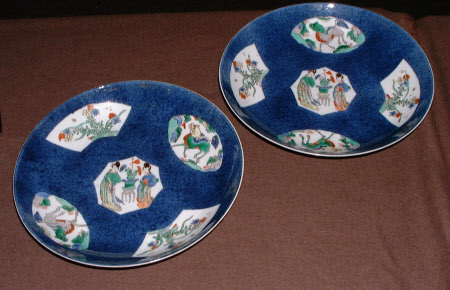Saucer dish
Category
Ceramics
Date
1700 - 1720
Materials
Porcelain, underglaze cobalt blue (powdered), overglaze polychrome enamels and gold
Place of origin
Jingdezhen
Order this imageCollection
Wallington, Northumberland
NT 581654
Summary
Two saucer-dishes or undertrays for a bowl (see 581606), porcelain, of shallow form, Jingdezhen, Jiangxi province, China, 1700-1720; decorated in underglaze blue with a powdered ground, and translucent polychrome (famille verte) enamels and gold, painted alternating four panels in reserve of oblong and fan-shape, the former with kylin or mythical beasts and the other with plant studies, dianthus, around a central octagonal panel with two tall standing women admiring a potted plant on a stand; the base with pseudo square seal mark painted in underglaze blue within double concentric circles.
Full description
This decorative technique using powdered cobalt as a ground colour is known as chuiqing ('blown blue'), and was extremely popular in the Kangxi period. Chuiqing involved blowing powdered cobalt through a bamboo tube with a filter onto unfired glazed vessels, over masked panels, the reserves, for a very refined appearance. Bowls and undertrays in matching patterns, usually long separated, survive in impressive numbers at Wallington, they may have been used to serve beef broth or other soup at breakfast as part of the morning toilette taken along in ones bed chamber or as a light repast at the end of the day. As it was a French fashion these sets, usually with a cover and two handles on the bowl are known as écuelle.
Provenance
Gift from Sir Charles Philips Trevelyan 3rd Bt
